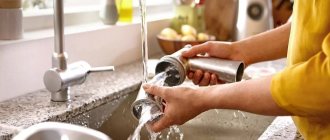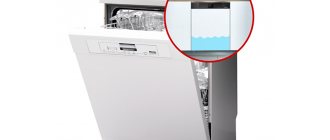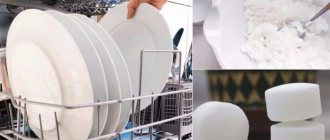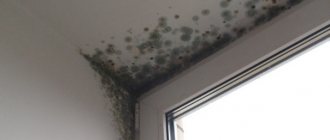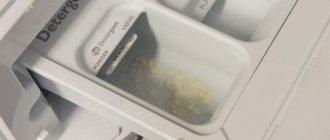Reduced water supply pressure and how to deal with it
When the water supply is poor, the machine cannot work fully.
And, naturally, the dishwasher leaves a white residue. The detergent is not washed out due to lack of water! If you know that this phenomenon occurs, then check this option. There may be a high probability of a decrease in pressure if the water supply comes from an autonomous source, a well
Therefore, first of all, check the water pressure in the tap. If you clearly see that he is weak, then this is clearly the reason. Then it’s worth dealing with the pump itself.
If you have a central water supply and the water pressure is reduced, then you will only have to wait for the moment when the pressure returns to normal. Naturally, if this is a one-time phenomenon.
But, if this problem is permanent, then it is worth starting to fight it. There are several options to solve this issue:
- Cleaning the filter in front of the meter
- Laying larger diameter pipes
- Installing a pressure booster pump
- Installation of a storage tank and pumping station
Which of these methods is right for you, you need to decide on the spot and based on the situation.
Preventive actions
What to do if the dishwasher leaves residue on the dishes. It is better to prevent a problem than to fight it. To achieve this, the following preventive actions are taken:
- pour salt or liquid softener into a special container;
- We use high-quality rinse aid in the right dosage;
- choose tablets that dissolve well in water and soften the liquid;
- we install additional filters to increase the efficiency of water purification;
- We correctly select and dose detergents for dishes.
When choosing tablets, we select substances that are designed to work in fast programs. They can be replaced with special solutions and powders. Rinse aid and salt should be placed in separate containers.
Cleaning procedure
To prevent dirt from accumulating on the doors, they are regularly washed with a wet cloth or napkin soaked in a soapy solution.
You need to wipe the machine, the body of which is made of stainless steel, with a special cleaner, and the control panel with a dry cloth. Drops of liquid should not fall on the buttons.
Washing the strainer
Once a week, it is recommended to remove the shelves from the chamber, soak them in detergent and dry them with a soft cloth. Every 7 or 8 days, it is necessary to remove the mesh filter from the lower basket, soak this part in a soapy solution, rinse with cool water, and return it to its place.
Cleaning the blades
Food residues and hard liquids clog the holes through which the soap solution enters the dishwasher. Clogged blades that supply water must be removed and cleaned with wire, rinsed under the tap.
Processing of seals
In order for household appliances to perform their functions for a long time and efficiently, it is worth purchasing a special chemical composition in the store, which is applied with a sponge to the seal that is installed on the dishwasher door.
How to clean a drain hole
If the equipment has stopped and there is water inside, the equipment must be disconnected from the electrical network. After this, you must carefully remove the drain hose. Any blockage found in the hole must be broken through with wire or the “Mole” preparation. If the water does not drain, you need to disconnect the other end of the hose from the dishwasher and rinse under high pressure.
Cleaning the heating element
The scale that forms on various parts of household appliances contributes to the malfunction of the device. The water remains cold if plaque appears on the heating element. You can clean it with citric acid and vinegar. The product is poured into a cup, placed on the top shelf and the machine is turned on.
Cleaning the Trash and Dead Zone
Debris constantly accumulates inside the bottom of the door because liquid does not get there. Remove dirt with a cloth soaked in soapy water. The “dead zone” is disinfected from microbes with vinegar.
To clean grease and scale:
- The baskets are removed and placed in the bath.
- Pour boiling water and add detergent.
- After half an hour, the debris is removed with a sponge.
After rinsing with water, all parts are wiped dry. Baskets are installed in the car.
Checking the condition and cleaning of the sprinklers
Sometimes after washing the drain holes, blades and filter, the dishes come out of the machine in a dirty state. This problem occurs when the detergent is not distributed evenly. To eliminate it, the upper spray arm is removed and cleaned of grease by pulling a wire or wiping it with soda or vinegar. Check how the part functions by placing it under a powerful jet.
Final processing
Having installed the sprinkler in place, turn on the machine, selecting normal mode. If water does not flow well into the tank, remove the inlet valve by unscrewing the nut and replace it with a new element. After processing all parts and cavities, the device is wiped dry, cleaned with lemon juice and washed off with a cotton napkin. The car door is not closed.
Before starting, the equipment is cleaned in the drain. Set the temperature regime for the water heater. Load the dishes so that the solution covers them completely. The amount of washing gel is added in accordance with the instructions.
Dishwasher breakdown
But often, dishwasher breakdowns can cause a white coating to appear on washed dishes. The main and most common problem is the failure of the water hardness sensor. It is he who determines how much softening solution to add to the water when running the dishwashing program.
Often its electrodes give false readings due to deposits that appear on them. In this case, washing the machine with a special product will help, which will also wash the sensor electrodes. But if after washing the situation has not changed, then the sensor needs to be changed. When replacing, be sure to check the wiring and connection terminals of the sensor. Sometimes their oxidation leads to incorrect determination of the water hardness level.
Also, a problem may be a malfunction of the mechanical parts of the system for supplying the softening salt solution to the tank during washing. In this case, all stages should be carefully examined for damage or clogging. All this is done visually. If a problem is found, it is fixed.
In addition to white residue, an unpleasant odor may appear in the dishwasher. To prevent this from happening, you can run the dishwasher twice a month on a short wash cycle, without dishes inside, with the addition of regular table vinegar. Apple cider vinegar is good for removing unpleasant odors.
In conclusion, we can say that if you do everything on time, clean, rinse, use only high-quality chemicals, then a large number of problems with the dishwasher can be avoided and it will last a long time.
In the video: the dishwasher does not clean well - white residue in the dishwasher, how to fix it yourself.
The dishwasher does not wash or rinse dishes well
How to prevent white plaque from appearing
Any dishwasher model is equipped with a filtration system. It consists of several filters. They trap food particles, during operation fat settles on them and scale forms.
Whitish stains and an unpleasant odor indicate that the dishwasher needs urgent cleaning.
The best way to remove dirt and lime deposits is with special chemicals:
- Filtero;
- Somat;
- Finish Machine Cleaner;
- Electrolux.
The use of special drugs is standard. The bag or bottle with the product is placed in the empty interior of the dishwasher. Run the program twice, running for at least 45-90 minutes. The first cycle is for cleaning (maximum water temperature), the second time is to remove traces of chemicals.
If the plaque cannot be removed, you should contact the service department. This will help avoid machine breakdown. The water hardness sensor may have failed or the filter needs to be urgently replaced.
How to remove?
To remove an unpleasant aroma, it is necessary to determine the provoking factor. Depending on this, the cleaning method will depend. If you suspect an electrical problem, you should contact a professional. It is prohibited to use the device after this; it can be life-threatening. This problem can be identified by the smell of burning.
If the smell is putrid in nature, we are talking about rubbish problems that can be easily eliminated at home. To do this, you need to choose the right method and means. But you should know that abrasive substances negatively affect the metal parts of the dishwasher, so their use is not recommended. Prohibited substances include:
- washing powder;
- chlorine-based cleaning products;
- substances that can corrode rubber materials.
Cleaning the inner container of the dishwasher
A coating of small food particles and fat remains on the walls of the machine. When they accumulate, they begin to smell bad. To prevent this problem from arising, it is necessary to thoroughly wipe the walls and dry them after each session. To eliminate the unpleasant odor that appears, you need to:
Before the procedure, all internal structures must be removed.
- clean the container from grates and shelves;
- wipe the walls with detergent, repeat the procedure with the internal parts, but in the basin;
- Initially, wipe off the deposits between the door seals and then rinse them with water.
Cleaning the drain filter
This is the place where the most dirt accumulates, so most often it is the cause of the unpleasant odor. To ensure that your dishwasher lasts a long time and there are no odor problems, you should thoroughly clean the dishes. But if such a problem occurs, you can fix it in the following way:
- Remove the protective mesh at the bottom of the device and remove the filter from there.
- Clean with boiling water and soap, using a brush.
- Dry and wipe with a cotton towel, only after that the filter is placed in place.
Before removing parts, you must carefully study the instructions for the electrical appliance.
Cleaning the drain hose
The smell of rot appears if water collects in it after washing dishes. Additionally, dirt can also accumulate here after washing. A day is enough for the leftovers to begin to develop aromas. To clean the drain hose and thus get rid of the unpleasant odor, you need to disconnect it from the device and drain the water into the sink. Then wipe the walls using a long wire. To disinfect, it is better to rinse the hose with hot water and cleaning agent.
Cleaning must be done carefully; thin walls can be easily damaged by wire or abrasive substances.
Household chemicals
On the shelves of hardware stores you can find a large number of products designed for dishwashers. They carefully remove plaque without harming the surface and leaving no marks on the metal. The powder, tablet or gel is poured into the detergent container and the empty device is turned on. After cleaning, you need to rinse the machine 2-3 times and only then wash the dishes there. When choosing a product, it is better to focus on what the manufacturer recommends.
Using improvised means
Store-bought cleaning products are expensive, so many housewives prefer traditional recipes. They have a number of advantages: they are inexpensive, can be found in every home, and carefully eliminate any odor. At the same time, the influence of chemicals is minimized, so this type of washing is safe for people. The main thing is not to exceed the norm and not to clean too often.
Table vinegar
The substance not only removes unpleasant odors, but also fights scale on the heating parts of the machine. The cleaning procedure follows the following scheme:
- Fill a glass with vinegar and place it in the reading compartment.
- Turn on the dishwasher.
- After switching off, open for 30 minutes.
Baking soda
You can fight greasy deposits and unpleasant odors inside the dishwasher with cheap products. Baking soda is available in every kitchen; to effectively eliminate the problem, 100 grams of the substance is enough. It is poured onto the bottom of the machine and the normal washing mode is turned on. This cleaning has a number of advantages: the surface becomes clean, it shines, in addition, soda has a disinfecting effect. There is no need to rinse the dishwasher after the procedure; you can immediately load dirty dishes. For prevention, you can wash your parting with baking soda once a month.
Removing white plaque
If white limescale remains on the dishes or walls of the structure, then it is necessary to adjust the degree of water hardness and, before starting the unit, adjust the salt supply to the required value.
How to determine water hardness:
- Use special test strips.
- Seek advice from housing office employees.
To correct the appearance of deposits, you need to adjust the salt supply in the dishwasher by studying the product's instruction manual. To obtain “soft” water, pour regenerating salt into a special device, which will regulate the hardness of the water in the water supply (in the future, monitor its quantity).
An equally common cause of white spots and streaks is poor quality and incorrect dosage of detergent.
Plaque on dishes occurs if:
- The powder didn't wash off well.
- The tablet did not dissolve completely.
- Poor quality of rinse aid (lack of it).
It is important to correctly determine the calculation of rinse aid for one wash - if there is a shortage, a white coating will remain on the dishes, and if there is an excess, there will be excessive shine and a welcoming film. Low quality tablets (3 in 1) are poorly washed out. White streaks may appear due to regenerating salt getting into the washing chamber.
In this case, you need to thoroughly clean the loading area from its residues and tighten the compartment lid tightly.
Traditional methods
Budget options - soda, vinegar, lemon (citric acid), salt, eucalyptus or tea tree essential oils. You can use it pure or dilute it with water in a certain consistency, depending on the task at hand - remove stubborn stains, rinse the machine after operating mode.
Professional products
The choice of means for descaling a dishwasher depends on the personal preferences of the consumer - household chemicals in the form
- Finish;
- HG;
- Soda sun;
- Somat;
- Toppe.
When in contact with caustic compounds, protect your hands and face from contact with detergent using gloves and a gauze mask. Upon completion of work, thoroughly ventilate the room.
Problems with the machine
Malfunctions in the operation of the unit can provoke the appearance of plaque on the dishwasher and dishes. You can fix the problem yourself by cleaning the dishwasher.
- Wash the filters.
- Then run a wash with a cleaning agent to remove deposits from the walls of the device and eliminate the unpleasant odor.
Fault prevention:
It is also necessary to inspect the lid of the compartment for salt and household chemicals
If it jams, then sharpen the product with a file, adjusting the size. You need to check the indicators of the water hardness sensor, but it is better to fix such a breakdown with the help of a specialist. It is important to regularly check the coarse and fine filters for contamination. To clean the blades, you need to remove them from the machine and rinse them under running water using detergent. The holes on the device are cleaned with a toothpick; you can use dishwashing gel or soap solution. The seals also need to be cleaned - use a washcloth or toothbrush.. https://www.youtube.com/embed/AUyoAmTOH_s
Reasons for the appearance of white plaque on dishes
Equipment is not insured against breakdowns or failures. Before sending the machine to a service center, study the factors that reduce the quality of the dishwasher. Once you determine the causes of contamination, you will be able to deal with the problem yourself.
Hardness of water
If there are white stains on plates, mugs, or the internal surfaces of the machine, the coating is caused by the composition of the water: excess lime deposits. The liquid in the city pipeline system includes heavy impurities of magnesium and calcium salts; they settle on the walls of the dishwasher.
After cleaning the devices, residue remains on the internal parts. Over time, the white, dirty layer of plaque thickens and causes machine breakdown.
Some dishwasher models are equipped with test strips to check the pH level of well water. If there are no fixtures, examine the surface and internal cavities of the plumbing fixtures. Hard liquid leaves a dull residue. When boiling, a white sediment appears in the kettle.
A neutralizing ion exchange system is installed inside the machine. This is a container containing a resinous substance. The dishwasher cavity is filled with regenerating salt. Water enters the device and passes through a cleaning filter that neutralizes metals.
Lack of salt, its deficiency leads to the formation of plaque. If the product is added at a signal from the machine, dirt remains, change the dishwasher settings. Malfunctions in the water hardness regulator cause insufficient supply of white matter and provoke the appearance of sediment.
Replace salt with expensive, high-quality salt: sometimes the composition is not suitable for a dishwashing machine.
The reason for the formation of plaque on surfaces may be caused by violations of the salt filling procedure: crystals have entered the dishwasher. To eliminate white sediment, check:
- tight fit of the lid on the ionizer container;
- presence of cracks in the machine structure.
The crystals are poured before starting the dishwasher. To prevent unpleasant consequences, white streaks, and plaque, do a single procedure without loading the equipment. If the manipulations were carried out according to the instructions, a sediment remains, pay attention to the cleaning agents.
Detergent
Plaque on dishes after the dishwasher can be a result of the use of cheap household chemicals. To remove white residue from the surface of plates, pots, and mugs, three preparations are used: washing powder or gel, rinse aid, and salt.
During the drying process, condensation should be carried out well, this will reduce the likelihood of streaks and deposits on the devices.
Not all machine models are suitable for complex 3-in-1 product options that combine the functions of three products. Dishwasher tablets may contain insufficient concentrations of substances and may not be suitable for the composition of the water.
Universal preparations do not cope well with white deposits in a fast cycle, but they effectively perform their functions in a long cycle without leaving a residue. Products require more time to dissolve the components inside the capsule.
The dosage of dishwasher detergent is indicated on the packaging. By following the instructions, you can choose the best option for washing utensils in a machine without creating a white residue.
Equipment malfunction
If, after self-diagnosis of the products and following the instructions for using the dishwasher, plaque remains, inspect the device. Analyze the localization of contaminants: formations on dishes and the internal walls of the machine indicate a breakdown. An additional factor signaling a malfunction is a greasy film on surfaces.
The cause of plaque may be damage to the water hardness adjustment sensor in the dishwasher. The machine module automatically determines the amount of salt; if it breaks down, the white crystals will stop entering the system and will be used in insufficient dosage.
Failure occurs due to improper use of detergents. Repairs are being carried out to solve the problem.
The cause of the white layer of deposits may be clogged filters in the dishwasher. Call a technician to clean the elements and replace them.
Other
The formation of streaks, white spots, and deposits on dishes can occur due to improper loading of the device or selection of an inappropriate program. You cannot install more items than those specified by the manufacturer in the instructions. Properly arrange small glass utensils and metal pans: this will help avoid drips.
Common reasons why white residue remains in your dishwasher are:
- failure to clean the drain filter after washing;
- food particles from plates that need to be removed before loading;
- refusal to use detergents.
If used incorrectly, filters and nozzles become clogged, which leads to damage to the dishwasher.
Three main reasons for the formation of plaque on dishes
There are only three reasons, but that doesn’t make it any easier. After all, finding the main one at random is not so easy. So here's the list:
- Technical difficulites
- Hardness of water
- Incorrect selection of detergents
It would seem that everything is simple. But, in fact, it’s not easy at all! Each of these reasons has a lot of nuances and it is very difficult for a beginner to understand it all.
Therefore, we advise you to start diagnosing with technical problems first. Of course, if you know for sure that yesterday the dishes were cleaned, and today, after changing the detergent, plaque suddenly appeared, then that’s the problem. Change it and be done with it!
But, if you have a new machine, and the very first wash disappointed you, or if you have an old machine that always washed well, but over time began to leave a residue, then the matter is more complicated.
If you have had your machine for a long time, we recommend that you begin diagnostics in the sequence given in the table of contents.
If it’s completely new, then you need to start with the points: “Poor quality of detergent”, “Incorrect dosage as the cause of the problem”, “Water hardness and how to choose a product”, “Reduced water supply pressure and how to deal with it”.
White residue on dishes after the dishwasher: what to do
It is worth contacting customer service if the softener compartment cover is damaged. The unit cannot be operated with faulty parts. The spilled crystalline substance can cause corrosion of the internal surfaces of parts. To optimize the regulation of salt intake, you need to find out the hardness level of your tap water.
This is done in 2 ways:
- contact local water management authorities;
- purchase test strips.
Test strips can be found in departments specializing in the sale of household appliances. With their help, it is easy to find out the water hardness and adjust the salt supply. How to make adjustments is indicated in the operating instructions.
The softener must be refilled in accordance with the manufacturer's recommendations. Immediately after it, start the short washing mode. Prolonged exposure to salt water can negatively affect the filtration system and pump.
Review the consumption rate of detergent and its quality. Do not use tablets in express modes. Do not start the program if the rinse aid dispenser is empty or the “Refill Required” indicator is on. Adjust the flow taking into account the water hardness.
The main reasons for the formation of a white coating on dishes after washing in the dishwasher
The same coating can be found on the walls of the device itself. Why does he appear? Over time, deposits, dust, and plaque accumulate on the device. First of all, the device should be cleaned. The filters become clogged with food debris and should be cleaned. Plaque is removed using special means.
Quality and dosage level of detergents
The reasons for the white coating on dishes after washing in the dishwasher vary. One of them is improper distribution of detergent compositions. They may be of poor quality. If there is an excess of them, white spots also remain. Or maybe the amount of rinse aid and conditioner is too small. Sometimes the rinse aid is poured into the wrong compartment. Substances produced in tablet form do not always have time to dissolve. Do not confuse the compartments for detergent compounds.
Incorrect distribution of detergent compositions can cause white residue.
Dishwasher hardness sensor failure
After washing in the dishwasher, a residue remains on the dishes if the housewife makes a mistake with the dosage of salt. To keep the water soft, you need to add the exact amount of ingredient. It is better to check the water hardness level from the company that supplies it. The hardness sensor shows the required amount of magnesium and calcium salts that can be added to the water. Otherwise, with a large dosage, they can leave a limescale deposit. If the sensor breaks down, call a technician.
The hardness sensor shows the required amount of magnesium and calcium salts that can be added to the water.
Wrong detergents selected
Each brand always has its own detergents. They must be of high quality so as not to damage the car. If they are incorrectly selected, then a coating will form on the car in a short time.
When washing dishes, some of the scale will fall on it. IMPORTANT: There is no need to purchase capsules; they contain the cheapest and most ineffective products. Why waste money on poor quality products when you can buy excellent products from the following brands:
- Frost Soda;
- Claro;
- Calgonut Finish gel;
- Clean Fresh Active Oxygen Lemon.
Washing dishes with these compounds will save the housewife from many problems. Also, it is necessary to observe the correct dosage, pour each substance into its own hole.
Washing dishes with these compounds will save the housewife from many problems.
Hard water problem
Why does a white residue remain on the dishes after washing them in the dishwasher? If the water is hard, it contains a huge amount of salts and impurities. They settle on the dishes, and limescale and deposits may remain on the walls of the machine. In order to soften water, you need to add the necessary elements to it. It is better to take samples and conduct water hardness tests in special laboratories.
Each dishwasher has a salt container. It happens that the salt runs out. The problem here is easily solved. The ingredient should be added again.
To reduce water hardness, softeners are added. Modern industry produces many good quality products. For example:
- Largo;
- Somat;
- Calgonit.
To reduce water hardness, softeners are added.
Irregular care
This can also cause streaks to appear on the dishes. Accumulated fats, food residues, and dirt may remain on the appliance. They are the cause of poor quality dishwashing. With such care, the operating time is reduced, the device and parts wear out faster.
Accumulated fats, food residues, and dirt may remain on the appliance.
Technical problems or violations of operating rules
In cases of serious damage, the owner will be forced to contact the service for help. This comes from negligence and laziness. Because they didn't bother to read the instructions. But electrical devices have clearly defined limits to their capabilities.
Electrical devices have clearly defined limits of their capabilities.
Incorrect immersion of dishes, incorrect washing mode for a given type of dishes, irregular care can cause technical problems. Contaminated filters can also leave streaks and lead to technical problems. They must be promptly cleaned of food residues. Poor quality cookware can also lead to technical problems.
Causes of white deposits on dishes and ways to eliminate them
There should be no sediment, streaks, stains, or white residue on the dishes after washing in the dishwasher!
If they appear, the reasons should be sought in:
- Incorrectly adjusted water hardness level. The regulator is set to softer water than what actually enters the unit.
- Lack of water softening salt in the appropriate container. The salt shortage indicator (if available) will tell you this.
- Errors when loading salt. It ended up at the bottom of the dishwasher or was mistakenly put in the wrong compartment.
- Wrong quantity or poor quality of detergents.
- Excessive soiling of the dishwasher. How long has it been since you cleaned and washed your “helper”?
- Malfunction of the water hardness sensor. In this case, the control module (“brain” of the dishwasher) receives an incorrect signal about the water hardness; it is not softened enough.
Accordingly, to eliminate the problems described above , you need to:
- Reset your dishwasher by reprogramming the water hardness control. If automatic adjustment is not provided, the manufacturer describes the manual adjustment process in the operating manual for the unit. Use these setup guidelines.
- Check the regenerating salt compartment. If it runs out, add more.
- Remember if the salt spilled on the bottom, or if you mistakenly poured it into another compartment. Carefully inspect the salt compartment. It could not be completely closed, and could also become deformed or crack. If you made a mistake, just be more careful next time. If the softening salt compartment is damaged, it must be replaced.
- Check the presence and correct dosage of powder, rinse aid or 3-in-1 product. Note! “3 in 1” tablets are not suitable for express washes. Make sure the quality of the products you use, try replacing them if in doubt.
- Clean the dishwasher: its filters, spray arms, door seal, drain hose, interior surface, and other parts. To learn how to do this, read “Cleaning the dishwasher: getting rid of unpleasant odors and preventing breakdowns.”
- Replace the water hardness sensor.
You can clean the dishwasher yourself , but it is better to entrust the removal of particularly difficult dirt and blockages to a professional.
Quality and dosage level of detergents
The reasons for the white coating on dishes after washing in the dishwasher vary. One of them is improper distribution of detergent compositions. They may be of poor quality. If there is an excess of them, white spots also remain. Or maybe the amount of rinse aid and conditioner is too small. Sometimes the rinse aid is poured into the wrong compartment. Substances produced in tablet form do not always have time to dissolve. Do not confuse the compartments for detergent compounds.
Incorrect distribution of detergent compositions can cause white residue.
Dishwasher hardness sensor failure
After washing in the dishwasher, a residue remains on the dishes if the housewife makes a mistake with the dosage of salt. To keep the water soft, you need to add the exact amount of ingredient. It is better to check the water hardness level from the company that supplies it. The hardness sensor shows the required amount of magnesium and calcium salts that can be added to the water. Otherwise, with a large dosage, they can leave a limescale deposit. If the sensor breaks down, call a technician.
The hardness sensor shows the required amount of magnesium and calcium salts that can be added to the water.
Wrong detergents selected
Each brand always has its own detergents. They must be of high quality so as not to damage the car. If they are not selected correctly, then a coating will form on the car in a short time. When washing dishes, some of the scale will fall on it. IMPORTANT: There is no need to purchase capsules; they contain the cheapest and most ineffective products. Why waste money on poor quality products when you can buy excellent products from the following brands:
- Frost Soda;
- Claro;
- Calgonut Finish gel;
- Clean Fresh Active Oxygen Lemon.
Washing dishes with these compounds will save the housewife from many problems. Also, it is necessary to observe the correct dosage, pour each substance into its own hole.
Washing dishes with these compounds will save the housewife from many problems.
Hard water problem
Why does a white residue remain on the dishes after washing them in the dishwasher? If the water is hard, it contains a huge amount of salts and impurities. They settle on the dishes, and limescale and deposits may remain on the walls of the machine. In order to soften water, you need to add the necessary elements to it. It is better to take samples and conduct water hardness tests in special laboratories.
Each dishwasher has a salt container. It happens that the salt runs out. The problem here is easily solved. The ingredient should be added again.
To reduce water hardness, softeners are added. Modern industry produces many good quality products. For example:
- Largo;
- Somat;
- Calgonit.
To reduce water hardness, softeners are added.
Irregular care
This can also cause streaks to appear on the dishes. Accumulated fats, food residues, and dirt may remain on the appliance. They are the cause of poor quality dishwashing. With such care, the operating time is reduced, the device and parts wear out faster.
Accumulated fats, food residues, and dirt may remain on the appliance.
Terms of use violated
If you have tried all previous versions and the steps taken were not successful, the reason for the raid may be a technical malfunction:
- The lid is stuck in the detergent compartment. Because of this, there is poor leaching of the powder or an undissolved tablet.
- The dishwasher filters are clogged.
- The sprinkler holes are clogged, resulting in low water supply pressure.
All of the above problems can be fixed yourself - fix the lid, wash the filter system, clean the holes in the sprinklers. After cleaning the PMM, run a dry wash using a special anti-scale and odor remover. For example, you can apply Finish Rinse or Calgonit Fusion Power.
Why does the dishwasher smell?
The dishwasher requires special attention and care. A prerequisite is compliance with the operating instructions. There can be several reasons why your dishwasher smells bad: stuck food waste, mold, unsuitable detergents, or stagnant water.
Leftover food
Food blockages are one of the common problems. Particles can settle in the filter, at the bottom of the dishwasher, or remain on the walls or surface of the door. You can observe the remains of unwashed food on the bottom bar of the machine, near the place where the door is attached. Also, if installed incorrectly, products settle on the drain pipe or the hose itself. If food waste remains in the unit, an unpleasant odor will certainly appear after a certain time.
Stagnation of water
Water may accumulate in a small amount in the pan of the machine. This is enough for the waste liquid to stagnate and a musty smell to appear. There may be several reasons for this phenomenon, but most often the drain hose was positioned incorrectly during installation. It is necessary to remove the liquid and run the dishwasher on the “Self-Cleaning” function. You can remove the water manually and wash the tray.
Failure to follow operating instructions
Not every kitchen utensil can be cleaned in the dishwasher. The instructions describe materials that cannot withstand high temperatures; plastic is prohibited. When heated, it begins to melt, causing a burning smell in the dishwasher. It is not recommended to place wooden cutting boards into the unit if they are glued together from several layers. When heated, the presence of glue will be felt, which will be problematic to get rid of.
Mold
Offensive odors in your dishwasher can be caused by mold. The fungus develops in hard-to-reach places: in water supply or drain hoses, near the heater, in the filter, in the door cuff. Visually determining where exactly the mold concentration is located is quite difficult.
Fungus can get into the car if the room is damp or the ventilation is poor
In this case, it is easier to prevent the appearance of odor than to fight it.
Advice! The dishwasher should be ventilated more often and should not be left with damp dishes in it with the door hermetically closed.
Unsuitable detergents
Special salt must be added to the kitchen unit to soften the water. The product also affects the quality of operation of household appliances and eliminates unpleasant odors. A liquid rinse (with or without fragrance) is also recommended.
If you use cheap detergent or do not follow the dosage, an unpleasant chemical smell may remain in the dishwasher, and a greasy film may remain on the walls.
Why does a new dishwasher smell while it's running?
When a new dishwasher is running, it may smell foul for several reasons:
- Household appliances are made of low-quality material, which when heated begins to emit an unpleasant odor. As a rule, the problem resolves itself after a few cycles.
- A more serious situation is accompanied by burning. The problem is that the contacts on the instrument panel of the car begin to melt. The cause may be voltage fluctuations in the network or manufacturer errors. In this case, you need to turn off the dishwasher and use the service.
- Burning wiring or a heating element is difficult to miss. The machine may still work for some time, the breakdown will appear later, but the smell will be present.
Important! At the first sign of burning, the equipment must be turned off and not used until the cause is identified and eliminated.
Why does my dishwasher smell like sewer?
A musty, sewer-like odor indicates a serious problem. It cannot be eliminated by cleaning the parts. If installation is carried out incorrectly, the unit will smell like sewage. The drain hose should be at an angle of approximately 40–100 cm above the floor, and not immediately mounted into the pipe. A siphon is required.
Correct installation of the drain hose will help eliminate sewer odor in the dishwasher.
Causes and solutions
There are several reasons for the appearance of stains, which are associated with the hardness of tap water, the quality of detergents and technical problems.
Hard water
A common reason why white streaks remain on dishes is increased hardness of the water that enters the dishwasher. Regular tap water contains many salts of heavy metals, as well as other impurities. After drying, a coating appears on washed items, which is formed by salts as they decompose.
To wash dishes, hot water is used, in which such impurities dissolve and subsequently remain on the appliances and internal parts of the machine in the form of a white precipitate.
In most regions of the country, water is very hard. This can be seen by how quickly scale forms in kettles and other appliances. The same thing happens inside the dishwasher. Limescale deposits cover heating elements and other parts, which impairs performance. If you do not fix it, the device will break down and will have to be repaired.
To soften the water flow, an ion exchange system is installed in dishwashers. The water passes through a container with a special resin and is softened to normal. To do this, you need to add regenerating salt to the machine compartment, which starts the ion exchanger. The product contains sodium chloride ions to neutralize hard metal salts.
Many dishwasher models have a water hardness regulator. Before starting the machine, you need to set it to the optimal value. In expensive multifunctional models, it is detected automatically. And if there is no such function, then you can make the settings yourself.
You can determine water parameters using special strips that come with the device. One end of the strip needs to be lowered into water and after a while the indicator will show its hardness. If the kit does not include such tests, you can find out the indicator in the city water supply department.
Detergents
Another common cause of cloudy stains on dishes can be poor quality detergents and care products, as well as their incorrect dosage. White spots may appear as a result of:
- poor quality powder;
- poorly soluble tablet drugs;
- in the absence of rinse aid or its poor quality.
When operating dishwashing equipment, only specialized preparations should be used. In this case, you need to use all three products - detergent, regenerating salt and rinse aid. Choose products from well-known, trusted brands.
You cannot put regular hand wash detergents into the machine because they are not suitable for use in an automatic machine. This is because the machine uses higher temperatures. Therefore, do not replace this detergent with other home remedies in order to save money. Repairing a car in the event of a breakdown will cost much more.
Salt and rinse aid must be added strictly to the compartment allocated for them. It is unacceptable to pour rinse aid into the powder compartment, as is done in washing machines. You also need to monitor the amount of drugs. Many dishwasher models have indicators for the level of salts and care products.
Many manufacturers of 3-in-1 tablet products claim that the use of tablets can replace salt, since it is already contained in the briquettes. However, regenerating salt should be added separately.
technical issues
Sometimes the cause of plaque and cloudy stains on dishes can be equipment breakdowns associated with defects or poor quality care of the machine. Among these problems are:
- ill-conceived design of the detergent compartment;
- clogging of the filtration mesh;
- formation of limescale on heating elements;
- clogged sprinklers;
- water hardness sensor failure.
When the cause is blockages in parts of the device, you need to clean it. To do this, you need to remove and clean the filters, drain hose and other dismountable parts. After such cleaning, you need to start the washing mode with detergent. This will remove deposits on the internal parts of the machine. Such procedures should be carried out regularly 1-2 times a year.
If streaks and deposits appear on the surface of washed dishes, it is worth finding out the quality of the detergents, checking their dosage and the operation of the machine’s sensors. And to extend the life of your dishwasher, take care of it regularly.
Reasons for poor dishwashing
What should you do if a white coating is visible on your plates, pots and kitchen utensils after being washed? You will always have time to call the service center, so don’t force things - try to first find out why the dishes are white. You may be able to cope without the help of specialists.
Hard water
Basically, the dishwasher leaves white spots on the washed dishes due to increased water hardness. When the latter contains a lot of dissolved metal salts, whitish stains remain after washing - they are especially visible on dark surfaces. That is why the PMM has built-in ion exchangers that supply sodium ions to the water. To ensure the neutralization of potassium and magnesium ions, which are the cause of high hardness, you have to periodically add salt to a special compartment of the machine. Not an ordinary cookery one, but a special one - for PMM.
If the salt compositions are not added in a timely manner, the ion exchanger will work worse and worse, and then fail - you will have to spend money on replacing it. A deposit appears - the user is warned that he needs to take care of the ion exchanger by adding salt to the machine.
Salt consumption is selected depending on the water hardness in the region. This information is in the instructions for the machines. The reason for the appearance of streaks can also be the incorrect setting of the equipment - if the set hardness does not correspond to reality, there will not be enough salt.
Poor quality detergent or incorrect dosage
White streaks may appear due to:
- Poorly washed off powder (overdose or poor quality).
- Poorly dissolved tablet. This product often leaves smudges, so don’t buy the very budget versions.
- Lack of rinse aid. Its use is mandatory. You need to make the right settings - too much rinse aid is just as bad as too little. If you overdo it, a characteristic rainbow film will appear on the plates. There is no need to spend money on mouthwash if you use three-in-one tablets.
You don’t really need to rely on the presence of salt in combined tablets; it may not be enough to soften the water - then you have to add the salt composition.
Users often make the mistake of pouring the rinse aid at the same time as the powder. As a result, the rinse aid is consumed during washing. His services are needed after the 1st rinse.
The effect of any tablet manifests itself differently in specific conditions - it is affected by hardness, loading, type of machine, and resource consumption. Each user must choose the optimal combination of products, dosage and settings.
Terms of use violated
If you have tried all previous versions and the steps taken were not successful, the reason for the raid may be a technical malfunction:
- The lid is stuck in the detergent compartment. Because of this, there is poor leaching of the powder or an undissolved tablet.
- The dishwasher filters are clogged.
- The sprinkler holes are clogged, resulting in low water supply pressure.
All of the above problems can be fixed yourself - fix the lid, wash the filter system, clean the holes in the sprinklers. After cleaning the PMM, run a dry wash using a special anti-scale and odor remover. For example, you can apply Finish Rinse or Calgonit Fusion Power.
The compartment lid often gets stuck in budget Chinese PMMs. To repair it, it is easier to install a working tray. The second option is to use a file to adjust the dimensions of the lid to the ideal.
Hardness sensor failure
If the dishwasher is equipped with a similar sensor, then it is possible that the appearance of streaks was caused by its breakdown. Such devices are installed in expensive models to control the consumption of regenerating salts while washing dishes. In this technique, adjusting the salt supply is not necessary.
If the sensor breaks down, the software module receives incorrect information about the actual stiffness. As a result, there is no sufficient water softening. There is only one solution to the problem - install a new sensor.
The pressure in the water pipes has dropped
If the water supply pressure decreases, the device does not operate at full capacity, and the quality of washing decreases. As a result, the powder is poorly washed off and a residue remains. This phenomenon is especially often observed when using wells. To check the pressure, just unscrew any tap: if the stream is weak, you will have to find out what happened to the pump, and the dishwasher has nothing to do with it. With a central water supply, all that remains is to wait for the pressure to increase. Well, if low pressure is a constant phenomenon, try to solve the problem using the following methods:
- Clean the coarse filter installed in front of the meter.
- Install larger diameter pipes.
- Install a pressure booster pump.
- Install a storage tank and a mini pumping station.
The ion exchanger has failed
If all means have been tried, but there is no improvement, the last, most unpleasant option remains - the ion exchanger has broken down. Breakdown is infrequent. This happens if:
- Do not replenish salt costs for a long time.
- Not special, but regular salt was used.
- The stiffness sensor is broken (in models that have it).
The ion exchanger is not cheap, but in order for the PMM to continue to work, it will have to be replaced.
Conclusions and useful video on the topic
Video about the causes of plaque in the dishwasher and the most effective way to eliminate them:
Plaque on dishes is an unpleasant phenomenon, but quite common. It’s not difficult to get rid of it; you need to soften the water and clean the equipment in a timely manner. If the machine is operated correctly, the likelihood of problems occurring will be minimal.
Want to talk about a simpler and easier way to get rid of the white mineral deposits that form in your dishwasher? Do you have an effective technique that is worth sharing with site visitors? Please write comments in the block below, ask questions and publish photographs on the topic of the article.

